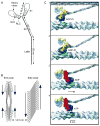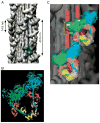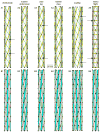Invertebrate muscles: thin and thick filament structure; molecular basis of contraction and its regulation, catch and asynchronous muscle
- PMID: 18616971
- PMCID: PMC2650078
- DOI: 10.1016/j.pneurobio.2008.06.004
Invertebrate muscles: thin and thick filament structure; molecular basis of contraction and its regulation, catch and asynchronous muscle
Abstract
This is the second in a series of canonical reviews on invertebrate muscle. We cover here thin and thick filament structure, the molecular basis of force generation and its regulation, and two special properties of some invertebrate muscle, catch and asynchronous muscle. Invertebrate thin filaments resemble vertebrate thin filaments, although helix structure and tropomyosin arrangement show small differences. Invertebrate thick filaments, alternatively, are very different from vertebrate striated thick filaments and show great variation within invertebrates. Part of this diversity stems from variation in paramyosin content, which is greatly increased in very large diameter invertebrate thick filaments. Other of it arises from relatively small changes in filament backbone structure, which results in filaments with grossly similar myosin head placements (rotating crowns of heads every 14.5 nm) but large changes in detail (distances between heads in azimuthal registration varying from three to thousands of crowns). The lever arm basis of force generation is common to both vertebrates and invertebrates, and in some invertebrates this process is understood on the near atomic level. Invertebrate actomyosin is both thin (tropomyosin:troponin) and thick (primarily via direct Ca(++) binding to myosin) filament regulated, and most invertebrate muscles are dually regulated. These mechanisms are well understood on the molecular level, but the behavioral utility of dual regulation is less so. The phosphorylation state of the thick filament associated giant protein, twitchin, has been recently shown to be the molecular basis of catch. The molecular basis of the stretch activation underlying asynchronous muscle activity, however, remains unresolved.
Figures








Similar articles
-
"Twitchin-actin linkage hypothesis" for the catch mechanism in molluscan muscles: evidence that twitchin interacts with myosin, myorod, and paramyosin core and affects properties of actomyosin.Arch Biochem Biophys. 2007 Oct 1;466(1):125-35. doi: 10.1016/j.abb.2007.07.014. Epub 2007 Aug 1. Arch Biochem Biophys. 2007. PMID: 17720132
-
Ultrastructure of invertebrate muscle cell types.Histol Histopathol. 1996 Jan;11(1):181-201. Histol Histopathol. 1996. PMID: 8720463 Review.
-
The myosin interacting-heads motif present in live tarantula muscle explains tetanic and posttetanic phosphorylation mechanisms.Proc Natl Acad Sci U S A. 2020 Jun 2;117(22):11865-11874. doi: 10.1073/pnas.1921312117. Epub 2020 May 22. Proc Natl Acad Sci U S A. 2020. PMID: 32444484 Free PMC article.
-
Mechanism of catch force: tethering of thick and thin filaments by twitchin.J Biomed Biotechnol. 2010;2010:725207. doi: 10.1155/2010/725207. Epub 2010 Jun 23. J Biomed Biotechnol. 2010. PMID: 20625409 Free PMC article.
-
Molecular basis of the catch state in molluscan smooth muscles: a catchy challenge.J Muscle Res Cell Motil. 2008;29(2-5):73-99. doi: 10.1007/s10974-008-9149-6. Epub 2008 Nov 28. J Muscle Res Cell Motil. 2008. PMID: 19039672 Review.
Cited by
-
Two Forms of Thick Filament in the Flight Muscle of Drosophila melanogaster.Int J Mol Sci. 2024 Oct 21;25(20):11313. doi: 10.3390/ijms252011313. Int J Mol Sci. 2024. PMID: 39457097 Free PMC article.
-
The effect of muscle ultrastructure on the force, displacement and work capacity of skeletal muscle.J R Soc Interface. 2024 May;21(214):20230658. doi: 10.1098/rsif.2023.0658. Epub 2024 May 22. J R Soc Interface. 2024. PMID: 38774960 Free PMC article.
-
Structure of the Drosophila melanogaster Flight Muscle Myosin Filament at 4.7 Å Resolution Reveals New Details of Non-Myosin Proteins.Int J Mol Sci. 2023 Oct 5;24(19):14936. doi: 10.3390/ijms241914936. Int J Mol Sci. 2023. PMID: 37834384 Free PMC article.
-
Bridging two insect flight modes in evolution, physiology and robophysics.Nature. 2023 Oct;622(7984):767-774. doi: 10.1038/s41586-023-06606-3. Epub 2023 Oct 4. Nature. 2023. PMID: 37794191 Free PMC article.
-
Mechanism of elastic energy storage of honey bee abdominal muscles under stress relaxation.J Insect Sci. 2023 May 1;23(3):2. doi: 10.1093/jisesa/iead026. J Insect Sci. 2023. PMID: 37220090 Free PMC article.
References
-
- Abbott RH. An interpretation of the effects of fiber length and calcium on the mechanical properties of insect flight muscle. Cold Spring Harb Symp Quant Biol. 1972;37:647–654.
-
- Abbott RH, Cage PE. A possible mechanism of length activation in insect fibrillar flight muscle. J Muscle Res Cell Motil. 1984;5:387–397. - PubMed
Publication types
MeSH terms
Substances
Grants and funding
LinkOut - more resources
Full Text Sources


